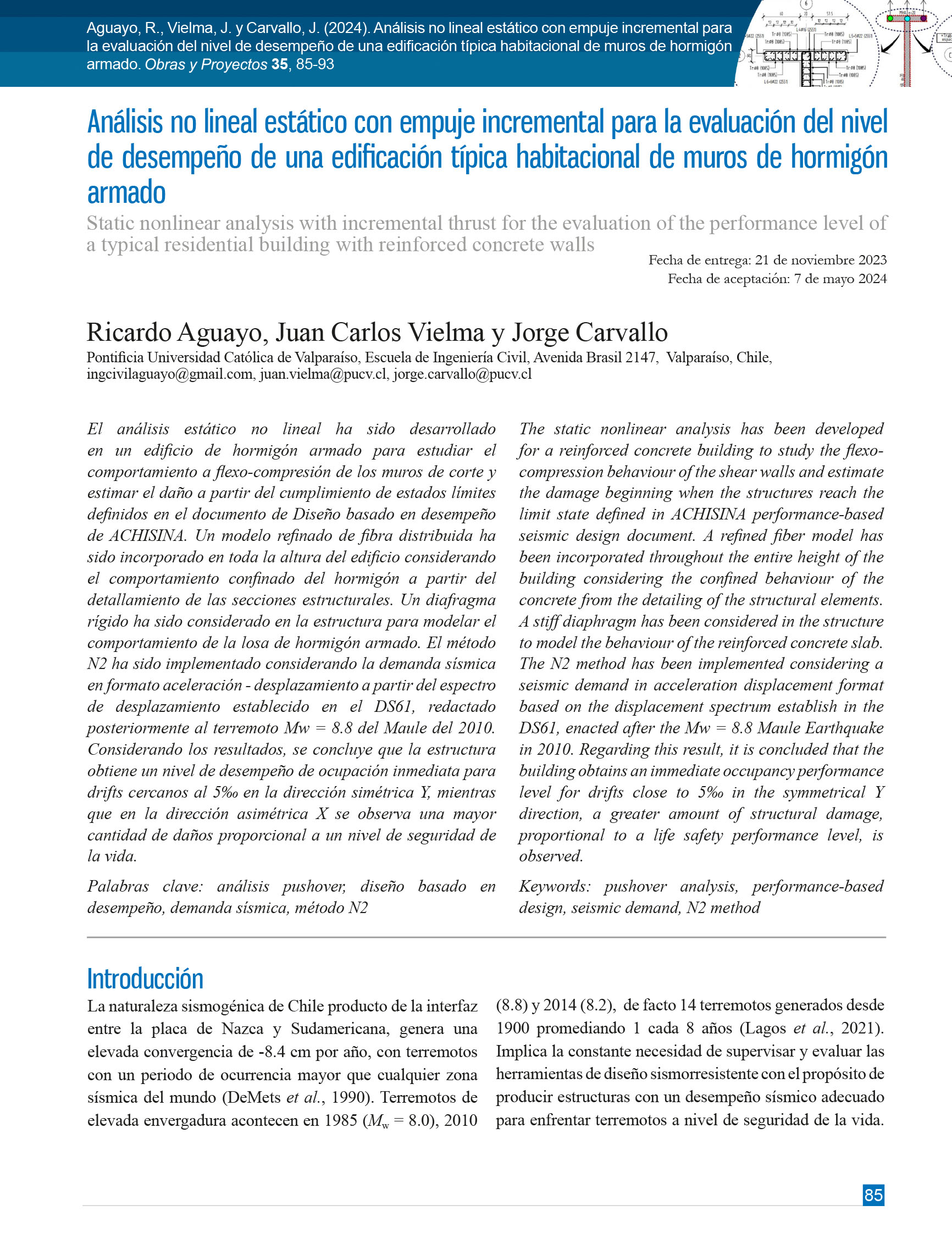Static nonlinear analysis with incremental thrust for the evaluation of the performance level of a typical residential building with reinforced concrete walls
DOI:
https://doi.org/10.21703/0718-2813.2024.35.2802Keywords:
Pushover analysis, Performance-based design, Seismic demand, N2 methodAbstract
The static nonlinear analysis has been developed for a reinforced concrete building to study the flexo-compression behaviour of the shear walls and estimate the damage beginning when the structures reach the limit state defined in ACHISINA performance-based seismic design document. A refined fiber model has been incorporated throughout the entire height of the building considering the confined behaviour of the concrete from the detailing of the structural elements. A stiff diaphragm has been considered in the structure to model the behaviour of the reinforced concrete slab. The N2 method has been implemented considering a seismic demand in acceleration displacement format based on the displacement spectrum establish in the DS61, enacted after the Mw = 8.8 Maule Earthquake in 2010. Regarding this result, it is concluded that the building obtains an immediate occupancy performance level for drifts close to 5‰ in the symmetrical Y direction, a greater amount of structural damage, proportional to a life safety performance level, is observed.
References
ACHISINA (2017). Diseño sísmico basado en desempeño – Un procedimiento alternativo para el análisis diseño sísmico de edificios. Santiago, Chile.
ASCE/SEI 7-16 (2017). Minimum design loads and associated criteria for buildings and other structures. American Society of Civil Engineers ASCE, Reston VA, USA.
Bertero, V. (1989). Lessons learned from recent catastrophic earthquakes and associated research. First International Conference Torroja, Madrid, Spain.
Carvallo, J. and Alcaíno, P. (2012). Behavior of reinforced concrete buildings in Viña del Mar. Lessons of February 27th 2010 Earthquake. 15th World Conference on Earthquake Engineering, Lisbon, Portugal.
Dautaj, A., Kabashi, N. and Sadiku, H. (2015). Method N2- According to Fajfar. International Journal of Civil and Structural Engineering 2(2), 363-369.
DeMets, C., Gordon, R.G., Argus, D.F. and Stein, S. (1990). Current plate motions. Geophysical Journal International 101(2), 425-478.
DS60 (2011). Aprueba reglamento que fija los requisitos de diseño y cálculo para el hormigón armado y deroga el DS118 de 2010. Ministerio de Vivienda y Urbanismo, Santiago, Chile.
DS61 (2011). Aprueba reglamento que fija el diseño sísmico de edificios y deroga el DS117 de 2010. Ministerio de Vivienda y Urbanismo, Santiago, Chile.
Fajfar, P. and Gašperšič, P. (1996). The N2 method for the seismic damage analysis of RC buildings. Earthquake Engineering & Structural Dynamics 25(1), 31-46.
Huang, C.L., Li, Y.F., Lin, C.T. and Hsu, T.H. (2011). Analytical and pushover analysis for predicting nonlinear forcedisplacement relationships of slender RC walls. Journal of the Chinese Institute of Engineers 34(3), 415–428.
Lafontaine, M. (2020). Diseño basado en desempeño de edificios. Seminario online Proyecto de actualización NCh433, ACHISINA, Santiago, Chile.
Lagos, R., Lafontaine, M., Bonelli, P., Boroschek, R., Guendelman, T., Massone, L.M., Saragoni, R., Rojas, F. and Yañez, F. (2021). The quest for resilience: The Chilean practice of seismic design for reinforced concrete buildings. Earthquake Spectra 37(1), 26–45.
Lagos, R., Kupfer, M., Lindenberg, J., Bonelli, P., Saragoni, R., Guendelman, T., Massone, L., Boroschek, R. and Yañez, F. (2012). Seismic performance of high-rise concrete buildings in Chile. International Journal of High-Rise Buildings 1(3), 181-194.
Mander, J.B., Priestley, N. and Park, R. (1988). Theoretical stress-strain model for confined concrete. Journal of Structural Engineering 114(8), 1804–1826.
Massone, L.M. and Bass, E. (2020). Dynamic shear amplification of reinforced concrete coupled walls. Engineering Structures 220, 110867.
Massone, L.M., Bonelli, P., Lagos, R., Lüders, C., Mohle, J. and Wallace, J.W. (2012). Seismic design and construction practices for RC structural wall buildings. Earthquake Spectra 28(S1), 245-256.
Menegotto, M. and Pinto, P.E. (1973). Method of analysis for cyclically loaded R.C. plane frames including changes in geometry and non-elastic behavior of elements under combined normal force and bending. Symposium on Resistance and Ultimate Deformability of Structures Acted on by Well Defined Repeated Loads, International Association for Bridge and Structural Engineering, Lisbon, Portugal, 15-22.
Montoya-Coronado, L.A., Biondini, F., Titi, A. y Bairán, J.M. (2017). Efecto de los modos altos de vibración en la respuesta sísmica no lineal de edificios de concreto. 2ndo Congreso Nicaragüense de Ingeniería Sísmica, Managua, Nicaragua.
NCh433 (2009). Diseño sísmico de edificios. Instituto Nacional de Normalización, Santiago, Chile.
Park, R. (1988). Ductility evaluation from laboratory and analytical testing. 9th World Conference on Earthquake Engineering, Tokyo-Kyoto, Japan, vol. 8, 605-616.
Plaza, R.E. (2017). Modelación no lineal, bidimensional y tridimensional de un edificio de hormigón armado. Memoria de título de Ingeniero Civil, Universidad de Chile, Santiago, Chile.
SEAOC (2008). Performance based seismic engineering of buildings. SEAOC Vision Committee. Sacramento CA, USA.
SeismoStruct (2020). A computer program for static and dynamic nonlinear analysis of framed structures (V2020). Seismosoft, Pavia, Italy.
Suquillo, B., Rojas, F. and Massone, L. (2018). Study of the seismic performance of a RC building with damage during the Mw 8.8 earthquake in 2010. 16th European Conference on Earthquake Engineering, Thessaloniki, Greece.
Telleen, K., Maffei, J., Willford, M., Aviram, A., Huang, Y., Kelly, D. and Bonelli, P. (2012). Lessons for concrete wall design from the 2010 Maule Chile earthquake. International Symposium on Engineering Lessons Learned from the 2011 Great East Japan Earthquake, Tokyo, Japan, 1766-1777.
Vielma, J.C., Barbat, A.H. y Oller, S. (2006). Factores de reducción de respuesta. Estado del arte y estudio comparativo entre códigos. Revista Internacional de Ingeniería de Estructuras 11(1), 77- 106.

Downloads
Published
Issue
Section
License

This work is licensed under a Creative Commons Attribution-NonCommercial 4.0 International License.







